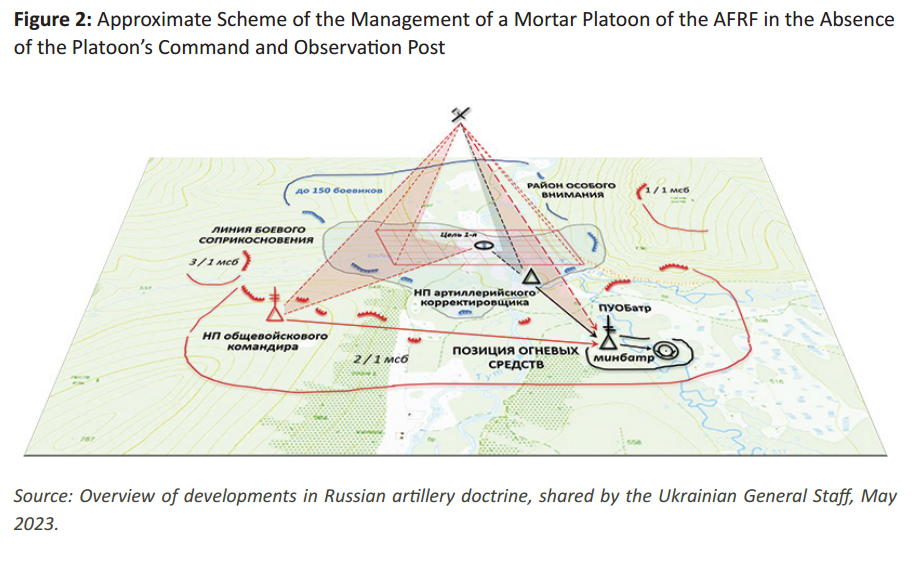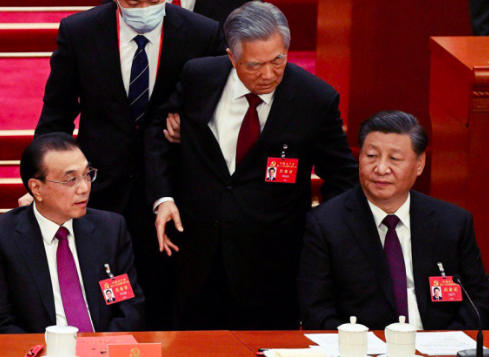
不要看开头的政治正确
这篇报告
从各个角度介绍了俄军对乌军碾压式的杀戮,虽然俄军目前未占领全境,但是压倒性屠宰乌克兰军人
不光老一套坦克、步兵、空军和地雷厉害,甚至在无人机和电子战都碾压
【Infantry】
Russian specialised troops are deployed as irregular groupings of snipers, artillery spotters
and support weapon operators.15While Ukrainian forces are suppressing disposable infantry,
additional disposable troops are often pushed forwards as working groups to dig fox holes
and prepare firing positions closer to Ukrainian defences. These personnel are withdrawn
and replaced by specialists who can establish observation and sniping posts or set up heavy
weapons. They can then be used to direct accurate fire against Ukrainian firing posts from a
range of up to 2 km and inflict attrition.
In the defence, Russian forces largely occupy company fighting positions with platoon-sized
elements that utilise minefields and obstacles to slow down and fix attackers before calling
for heavy defensive artillery fire.19If forced from their positions, they will utilise artillery fires to prevent either breakthroughs or consolidation by the attacker. Although Russian defensive
operations have been criticised as being overly positional, they do hold ground combat units in
reserve for mobile defence.
It is notable that Russian doctrine, with a heavy emphasis on direct and indirect fires, has long
prescribed that formations should dig in as soon as possible when static. If no engineering
support is available, they are to do so by hand, and are to continue to improve their positions
for the duration that they occupy them. As a result, Russian positions often include an extensive
range of well-prepared fighting positions. Once Russian troops have taken a position, it is reliably fortified within 12 hours through the digging of fox holes or blasting on less favourable ground.
【Engineers】
Russian defensive positions generally comprise two to three lines,
depending on the context. The first line, along the line of contact, comprises the fighting
positions made by the infantry. The second constitutes properly made trenches – as compared
with fox holes in the first – and concrete firing posts where possible. Several obstacle belts are
laid in front of these positions, usually formed with a 4-m-deep and 6-m-wide anti-tank ditch,
dragons’ teeth and wire track entanglements.24The trench positions are usually structured as
company fighting positions in wood blocks and on ridge lines, placed to cover areas of open
ground with fire, rather than as contiguously occupied front lines. The depth of the defence
line is usually 5 km from the first, and each belt of physical defences tends to span between
700 m and a kilometre, so that the entire obstacle series is covered by fire. The third line
usually comprises fall-back fighting positions and concealed areas for reserves, with positions
dug for vehicles. Command posts (CPs), meanwhile, tend to be subterranean and fortified with
concrete.25The overall depth of defensive fortifications exceeds 30 km on some axes.
The Russians have also made extensive use of magnetically activated
AT mines delivered via multiple launch rocket systems (MLRS). Although Russian forces have
been successful in tracking the routes through their own minefields, they have performed less
well in breaching mine belts laid by the AFU.28 Another area in which the Russians have demonstrated persistent competence is in the emplacement of bridges. These are largely held at the Combined Arms Army level and assigned to support operations. Engineering units usually emplace them rapidly and there is no evidence that the Russian Ground Forces lack for pontoon bridges, even if their river crossing operations have exhibited serious shortcomings overall.29Russian forces are sufficiently confident that they can rapidly deploy bridging that they have at times destroyed bridges, even on routes that they intend to utilise, because they assess that the disruption to Ukrainian forces is greater than the burden of having to erect pontoons across the gap.
【Artillery】
The patterns of fire are being described as ‘Nomadic
Cannon’, ‘Fiery Carousel’, ‘Roaming Platoon’ and ‘Umbrella Cover’. The Nomadic Cannon reflects harassing fire, delivered from mobile firing points, often to draw counterbattery fire or conduct artillery raids. The Fiery Carousel reflects a means of maintaining survivability while sustaining barrage. The Roaming Platoon concept envisages manoeuvring guns maximising the weight of
salvo deliverable against a target. Umbrella Cover is essentially a means of suppression.33Gun
positions are no longer dug. Instead, a battery will conceal itself in a woodblock and move to a
firing position where ammunition will have been placed for a defined salvo.34It will then move
to the next. If fixed by counterbattery fire, operators tend to leave their guns and seek cover,
only returning to them when it is safe to do so.
One underappreciated aspect of Russian fires reconnaissance early in the conflict was
the Strelets system. It allows multiple feeds from ground-based sensors or detections by
reconnaissance troops to be programmed and transmitted through a wide range of bearers,
which are then integrated into Russian digital fire control.
The actions of Russian assault groups against the village of Artemivske in December 2022
provides a useful illustration of the application of the RFC as it has developed in Ukraine. Several UAVs(无人机) were used to fly above the assault groups in the city: one conducted reconnaissance outside the city against the positions of the Ukrainian artillery; another maintained observation over possible routes for transferring reserves; a third preceded the assault group to identify Ukrainian ambushes and firing positions; and a fourth flew above the assault group itself, giving the assault group commander real time observation of the tactical situation. If any of the UAVs identified a target, the UAV operator would pass the coordinates to the assault group commander. If the target was to be engaged with artillery this would be either ordered by the
assault group commander and carried out by the artillery attached to the group, or transferred
to the higher command, operating its own UAVs over the area, which could take over the fire
mission with its assets. In this instance, the engagements were managed by the Strelets system.
【Armour】
One important development is that the Russians have made several modifications to their tanks
that are reducing the effectiveness of anti-tank guided missiles (ATGMs). First, they are fitting
vehicles – as well as many defensive positions – with anti-thermal material,46which is proving
highly effective. Second, modification to the engine deck and thus the heat plume from the
vehicle’s exhaust and engine is reducing the reliability of where certain ATGMs engage the
target. Third, by fighting at dusk and dawn when the vehicle temperature is most similar to
the ambient temperature of the surroundings (known as ‘thermal crossover’), the vehicles are
harder to detect through thermal imagery.47The result is a significant decrease in the probability
of kill from several ATGM types
【Electronic Warfare】
ELECTRONIC WARFARE REMAINS a critical component of the Russian way of fighting.
While there was an extremely high density of EW systems in Donbas in 2022, the
AFRF now employ approximately one major EW system per 10 km of frontage, usually
situated approximately 7 km from the frontline, with more specialised EW capabilities sat
at higher echelon.52These platforms are usually aimed at controlling and defeating UAVs.
Interestingly, there is minimal interest among Russian crews in synchronising these effects with
other activities or with deconflicting their effects. Instead, for the period when an EW team is
deployed, it is weapons free with its system and tends to aggressively attack Ukrainian systems.
The Shipovnik-Aero is proving a particularly effective system because it has a low signature and
can further obfuscate this by imitating other emitters and communications devices.53It also
has a sophisticated range of effects for downing UAVs.54The Russian military is also continuing
to make extensive use of navigational interference in the battle area as a form of electronic
protection. This is contributing to a Ukrainian loss rate in UAVs of approximately 10,000 per
month.
The Ukrainian troops were communicating with Motorola radios with 256-bit encryption, but it appeared that the Russians were able to capture and decrypt these transmissions in near real time. The most likely system for such functions is the Torn-MDM.57When the Russians are not intercepting traffic, Ukrainian units note that they are reliably able to suppress the receivers on Motorola radios out to approximately 10 km beyond the FLET.
Alongside large systems such as the Shipovnik-Aero, the Russian military has been extensively
rolling out EW effectors to be organic to units at all echelons. This includes counter-UAS
capabilities assigned to each platoon,59which usually include directional jammers and arrays
for hijacking UAVs. Ukrainian forces now assess that at least one of these systems is available to each platoon within Russian line infantry units. Another EW function in the counter-UAS
fight is deception measures that generate a large number of fake UAVs on enemy systems and
replicate ground control stations. While the Russian military is yet to widely exploit the creation
of a large number of false targets, it has the capability to do so – and these actions are growing
more prevalent.
出处
https://rusi.org/explore-our-research/p ... on-ukraine

